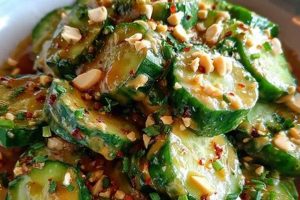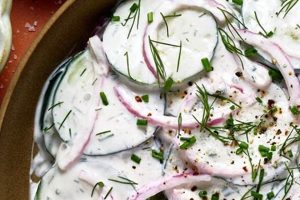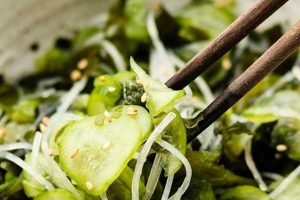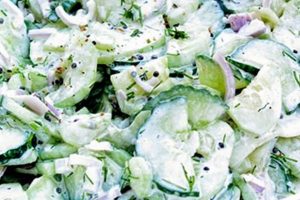A refreshing and flavorful dish, this culinary creation combines the creamy, tangy Greek yogurt sauce known as tzatziki with the crisp coolness of cucumbers. Often enhanced with fresh herbs like dill and mint, and sometimes with additions like garlic, lemon juice, or olive oil, the mixture results in a light and healthy side dish or appetizer. Variations can include other vegetables or a thinner consistency for use as a dip.
This type of salad provides a healthy and satisfying option, rich in probiotics from the yogurt and vitamins from the cucumbers and herbs. Its versatility allows it to complement a wide range of cuisines, from Mediterranean to Middle Eastern, and it can be enjoyed year-round. The simplicity of its preparation also makes it a popular choice for both casual meals and more formal gatherings. Its historical roots likely lie in similar cucumber and yogurt dishes found throughout the eastern Mediterranean region.
Discussions regarding this culinary concept frequently encompass ingredient selection, preparation techniques, variations, and suitable pairings. Exploring these aspects provides a deeper understanding of its appeal and its place within the broader culinary landscape.
Tips for an Excellent Cucumber and Tzatziki Salad
Achieving optimal flavor and texture requires attention to detail in ingredient selection and preparation.
Tip 1: Grate Cucumbers Coarsely: Coarsely grated cucumbers release less water, preventing a watery salad. Alternatively, thinly sliced cucumbers can be used but should be salted and drained beforehand to remove excess moisture.
Tip 2: Use Thick, Strained Yogurt: Greek yogurt, or labneh (strained yogurt), provides the best creamy base for tzatziki. Avoid thinner yogurts as they will result in a runny salad.
Tip 3: Drain Excess Liquid from Yogurt: Even with thick yogurt, straining off any excess whey intensifies the flavor and ensures a creamy, not watery, tzatziki.
Tip 4: Fresh Herbs are Key: Fresh dill and mint are essential for authentic flavor. Dried herbs can be used as a substitute if fresh are unavailable, but use them sparingly as the flavor is more concentrated.
Tip 5: Garlic in Moderation: Garlic adds a pungent note, but too much can overpower the delicate flavors of the other ingredients. Start with a small amount and adjust to taste.
Tip 6: Balance Acidity Carefully: Lemon juice or red wine vinegar provide necessary acidity, balancing the richness of the yogurt. A small amount is usually sufficient, but adjust to personal preference.
Tip 7: Chill Before Serving: Chilling allows the flavors to meld and enhances the refreshing nature of the salad. Ideally, chill for at least 30 minutes before serving.
By following these guidelines, one can create a flavorful and refreshing cucumber and tzatziki salad that highlights the individual components while creating a harmonious whole.
Careful consideration of these elements contributes to a superior culinary experience.
1. Fresh Cucumbers
Fresh cucumbers provide the foundational textural and flavor component of a successful tzatziki cucumber salad. Their selection and preparation significantly influence the overall quality of the dish. Understanding the nuances of cucumber varieties and handling techniques is crucial for achieving optimal results.
- Cucumber Variety Selection
Different cucumber varieties offer varying levels of water content and flavor profiles. English cucumbers, known for their thinner skin and fewer seeds, are a popular choice. Persian cucumbers offer a similar profile. Garden cucumbers, while more readily available, may require peeling and seeding due to thicker skin and larger seed cavities. The chosen variety impacts the final texture and taste of the salad.
- Cucumber Preparation Techniques
Proper preparation methods maximize flavor and prevent excess moisture in the final dish. Grating, slicing, or dicing are common techniques, each contributing a unique texture. Salting and draining grated or sliced cucumbers removes excess water, preventing a diluted tzatziki sauce. This step is particularly important for varieties with higher water content.
- Impact on Tzatziki Flavor Profile
The subtle, refreshing flavor of cucumbers complements the tangy tzatziki sauce. Their mildness allows the other ingredients, such as garlic and herbs, to shine without being overpowered. Overly mature cucumbers can develop a bitter taste, negatively impacting the overall flavor balance of the salad.
- Visual Appeal and Presentation
The vibrant green color and crisp texture of fresh cucumbers enhance the visual appeal of the salad. Careful preparation, whether through precise slicing or uniform dicing, elevates the presentation, making it more appetizing. The way the cucumbers are incorporated affects the final aesthetic of the dish.
The careful selection and preparation of fresh cucumbers directly influence the final quality, flavor, and presentation of a tzatziki cucumber salad. By understanding the nuances of cucumber varieties and employing appropriate handling techniques, one ensures a refreshing and flavorful culinary experience.
2. Thick Greek Yogurt
Thick Greek yogurt forms the foundational element of the tzatziki sauce, inextricably linking it to the tzatziki cucumber salad recipe. The yogurt’s texture, flavor profile, and interaction with other ingredients significantly influence the overall quality and character of the dish. A thorough understanding of these aspects is crucial for successful recipe execution.
- Texture and Consistency
The thick, creamy texture of Greek yogurt, achieved through straining to remove whey, provides the desired body and mouthfeel of the tzatziki sauce. This thickness prevents the sauce from becoming watery when combined with the cucumbers, ensuring a pleasant culinary experience. A thinner yogurt would result in a diluted, less appealing consistency. The yogurt’s texture also contributes to the overall presentation of the salad.
- Flavor Profile
Greek yogurt offers a characteristic tangy flavor that complements the other ingredients in the tzatziki cucumber salad. This tanginess balances the sweetness of the cucumbers and the sharpness of the garlic and herbs. The yogurt’s mild, slightly acidic taste provides a backdrop that allows the other flavors to shine without being overpowering. The quality and freshness of the yogurt directly impact the final flavor profile of the salad.
- Interaction with Other Ingredients
Greek yogurt acts as a binding agent, bringing together the diverse flavors and textures of the cucumbers, herbs, and garlic. Its creamy consistency coats the other ingredients, ensuring an even distribution of flavor throughout the salad. The yogurt’s mildness allows it to absorb and complement the flavors of the other ingredients, creating a harmonious blend. This interaction is key to the overall balance and complexity of the dish.
- Nutritional Contribution
Beyond its textural and flavor contributions, Greek yogurt adds nutritional value to the tzatziki cucumber salad. It is a good source of protein, calcium, and probiotics, contributing to the overall healthfulness of the dish. These nutritional benefits enhance the appeal of the salad as a nutritious and flavorful option.
The specific characteristics of thick Greek yogurt, from its texture and flavor to its interaction with other ingredients and nutritional value, are integral to a successful tzatziki cucumber salad recipe. Choosing the correct type of yogurt is essential for achieving the desired balance of flavors, textures, and overall culinary experience. This ingredient serves not only as a base for the tzatziki sauce but also as a key contributor to the salad’s overall quality and appeal.
3. Aromatic Fresh Herbs
Aromatic fresh herbs constitute an essential element within a tzatziki cucumber salad recipe, contributing significantly to its distinctive flavor profile and overall sensory experience. Their careful selection and application elevate the dish beyond a simple combination of ingredients, transforming it into a complex and refreshing culinary creation. Understanding the role of these herbs is crucial for achieving optimal results.
- Herb Selection and Flavor Pairing
Classic choices include dill and mint, their bright, herbaceous notes harmonizing with the cool cucumbers and tangy yogurt. Other herbs, such as parsley, oregano, or chives, can be incorporated to create nuanced flavor variations. The selection process should consider the overall balance of the dish, ensuring that the chosen herbs complement, rather than overpower, the other ingredients. Dill, for instance, provides a slightly anise-like flavor that pairs well with the creamy yogurt, while mint adds a refreshing coolness.
- Freshness and Quality
The quality of the herbs directly impacts the final flavor of the salad. Freshly picked herbs offer the most vibrant flavor and aroma. Dried herbs can be substituted when fresh are unavailable, but their flavor is more concentrated, requiring careful adjustment of quantities. Wilted or bruised herbs should be avoided, as their flavor can be diminished. The vibrancy of fresh herbs significantly enhances the overall sensory experience.
- Preparation and Incorporation Techniques
Proper preparation techniques maximize the flavor contribution of the herbs. Finely chopping the herbs releases their aromatic oils and ensures even distribution throughout the salad. Adding the herbs just before serving preserves their fresh flavor and vibrant color. Gentle handling prevents bruising and maintains their delicate structure. The method of incorporation influences both the flavor and visual appeal of the finished dish.
- Balancing Aromatic Intensity
The quantity of herbs used should be carefully considered to achieve a balanced flavor profile. Too much can overpower the other ingredients, while too little may result in a bland salad. The intensity of different herbs varies, requiring adjustments based on the specific herb chosen. Dill, for example, has a more pronounced flavor than mint, necessitating smaller quantities. Balancing the aromatic intensity is key to a harmonious and flavorful salad.
The inclusion of aromatic fresh herbs in a tzatziki cucumber salad recipe is essential for creating a truly flavorful and refreshing dish. Their careful selection, preparation, and balanced incorporation elevate the salad from simple to sophisticated, enhancing both its taste and aromatic appeal. Understanding these nuances allows for a more considered and ultimately more satisfying culinary outcome.
4. Subtle Garlic Flavor
Garlic’s role in a tzatziki cucumber salad recipe hinges on achieving a subtle, nuanced presence, rather than an overpowering pungency. This delicate balance significantly influences the overall flavor profile and enjoyment of the dish. The interaction of garlic with the other ingredientsyogurt, cucumbers, and herbscreates a complex interplay that elevates the sensory experience. Overpowering garlic can mask the refreshing qualities of the cucumbers and herbs, disrupting the intended harmony.
Consider a scenario where one clove of garlic, finely minced, is incorporated into the tzatziki sauce. This modest amount infuses the yogurt with a subtle warmth that complements the cool cucumbers. The garlic’s presence enhances the overall flavor complexity without dominating the palate. Conversely, using multiple cloves, or larger pieces of coarsely chopped garlic, can lead to an aggressive, pungent flavor that overwhelms the other delicate components. The refreshing nature of the salad becomes compromised, replaced by a dominant garlic taste. This illustrates the importance of moderation and careful preparation.
The practical significance of understanding garlic’s role lies in the ability to create a balanced and harmonious flavor profile. Achieving this subtlety requires careful consideration of both the quantity and preparation method of the garlic. Finely mincing or grating garlic distributes its flavor more evenly and mitigates its intensity compared to larger, coarsely chopped pieces. Roasting garlic before incorporating it into the tzatziki sauce can further mellow its sharpness and impart a subtly sweet, nuanced flavor. Mastering this aspect of the recipe allows for a more refined and ultimately more enjoyable culinary experience. The delicate balance achieved through subtle garlic flavor enhances the refreshing and complex interplay of ingredients characteristic of a successful tzatziki cucumber salad.
5. Balanced Acidity
Balanced acidity plays a crucial role in a tzatziki cucumber salad recipe, contributing significantly to its overall flavor profile and palatability. Acidity provides a necessary counterpoint to the richness of the yogurt and the mildness of the cucumbers, creating a more complex and refreshing taste. This balance prevents the salad from tasting bland or overly rich. The primary sources of acidity in this recipe typically include lemon juice or vinegar, although other acidic ingredients like citric acid could be considered. The specific choice and quantity of the acidic component influence the final taste and overall balance of the dish.
The impact of acidity can be illustrated through a comparison. A tzatziki cucumber salad lacking sufficient acidity might taste flat and overly creamy. The flavors of the yogurt, cucumbers, and herbs would blend together without distinction, resulting in a less vibrant sensory experience. Conversely, excessive acidity can create a sharp, overpowering taste that masks the subtle flavors of the other ingredients. The refreshing coolness of the cucumbers might be overshadowed by a dominant sourness. A well-balanced acidity, however, enhances the individual flavors of each component while creating a harmonious whole. The tanginess of the yogurt is complemented, the subtle sweetness of the cucumbers is highlighted, and the aromatic herbs are allowed to shine. This balance elevates the dish from simply palatable to truly delightful.
Understanding the role of balanced acidity allows for precise control over the final flavor profile of the tzatziki cucumber salad. Careful measurement and tasting throughout the preparation process are essential for achieving the desired balance. The specific level of acidity preferred can vary based on individual taste preferences and the specific ingredients used. However, the underlying principle remains consistent: balanced acidity is essential for creating a tzatziki cucumber salad that is both refreshing and flavorful. This understanding empowers one to create a dish that is not only delicious but also showcases a nuanced appreciation for the interplay of flavors.
6. Proper Chilling Time
Proper chilling time plays a crucial role in the development of flavor and texture within a tzatziki cucumber salad recipe. Chilling allows the individual componentsyogurt, cucumbers, herbs, and garlicto meld, creating a more cohesive and complex flavor profile. The cool temperature also enhances the refreshing nature of the salad, making it particularly appealing in warmer weather. This chilling process is not merely a final step but rather an integral part of the recipe, impacting the overall sensory experience.
The chemical and physical changes that occur during chilling contribute significantly to the final product. As the salad chills, the water content within the cucumbers and yogurt stabilizes, preventing excessive moisture release and maintaining the desired texture. Simultaneously, the flavors of the garlic and herbs slowly infuse the yogurt, creating a more nuanced and balanced taste. For instance, a freshly prepared salad might taste predominantly of yogurt, with the other flavors less pronounced. After a sufficient chilling period, typically at least 30 minutes, the flavors harmonize, resulting in a more complex and integrated taste experience. Chilling for longer periods, up to a few hours, can further intensify these effects. However, excessive chilling, beyond several hours, can negatively impact the texture of the cucumbers, making them overly soft. Therefore, optimal chilling time involves a balance between flavor development and textural preservation.
The practical significance of understanding proper chilling time lies in the ability to optimize the sensory qualities of the tzatziki cucumber salad. This knowledge empowers individuals to create a dish that is not only flavorful but also texturally pleasing. Failing to chill the salad adequately results in a less integrated flavor profile and a potentially watery consistency. Conversely, excessive chilling can compromise the crispness of the cucumbers. Therefore, adherence to recommended chilling times ensures a final product that exemplifies the intended balance of flavors and textures, maximizing the enjoyment of this refreshing and flavorful dish.
7. Versatile Serving Options
The versatility of tzatziki cucumber salad extends beyond its refreshing flavor profile to encompass a wide range of serving options. This adaptability makes it a valuable addition to various culinary contexts, from casual meals to more formal gatherings. Understanding these diverse applications allows for a more comprehensive appreciation of the salad’s potential and its integration into different culinary traditions.
- As a Standalone Side Dish
The salad’s refreshing nature and balanced flavors make it an ideal standalone side dish. It pairs well with grilled meats, fish, or roasted vegetables, providing a cooling counterpoint to richer, more savory dishes. The simple yet elegant presentation adds visual appeal to the plate.
- Incorporated into Larger Salads
Tzatziki cucumber salad can be incorporated into larger, more complex salads, adding a creamy, tangy element. Combining it with mixed greens, tomatoes, olives, and feta cheese creates a Mediterranean-inspired salad. This integration allows for customization and variation, catering to different dietary preferences and taste profiles.
- Served as a Dip or Appetizer
The salad’s texture and flavor profile lend themselves well to use as a dip. Served with pita bread, crudits, or crackers, it provides a refreshing and flavorful appetizer. This application highlights the versatility of the salad and its adaptability to different culinary scenarios. Adjusting the consistency by adding a little more yogurt or liquid allows for a smoother dipping texture.
- Accompaniment to Sandwiches and Wraps
Tzatziki cucumber salad adds a cool and creamy element to sandwiches and wraps. Its flavor complements various fillings, from grilled chicken or falafel to roasted vegetables. This usage extends beyond traditional Mediterranean cuisine, offering a refreshing twist to everyday sandwiches and adding a layer of complexity to the overall flavor profile.
The diverse serving options of tzatziki cucumber salad underscore its adaptability and value within a wide range of culinary settings. From a simple side dish to a component within more complex creations, its refreshing flavor and versatile nature make it a valuable addition to any meal. This adaptability contributes to the enduring popularity of the salad and its continued presence in various culinary traditions.
Frequently Asked Questions
This section addresses common inquiries regarding the preparation and enjoyment of tzatziki cucumber salad, providing clear and concise information to ensure a successful culinary experience.
Question 1: Can this salad be prepared in advance?
Preparation in advance is possible, but optimal flavor and texture are achieved when served within a few hours of assembly. Longer storage can result in excess moisture release from the cucumbers, potentially diluting the tzatziki sauce.
Question 2: What are suitable alternatives to Greek yogurt?
While Greek yogurt provides the ideal texture and tang, labneh (strained yogurt) offers a similar profile. Thicker varieties of plain yogurt can be substituted, but straining them beforehand is recommended to remove excess whey.
Question 3: How can excess moisture in the salad be prevented?
Salting and draining the grated or sliced cucumbers before combining them with the tzatziki sauce effectively reduces excess moisture. Selecting cucumber varieties known for lower water content, such as English or Persian cucumbers, can also minimize this issue.
Question 4: What can be done if the tzatziki sauce is too thick?
A small amount of milk or water can be added to the tzatziki sauce to adjust its consistency if it becomes too thick. This adjustment should be made gradually, ensuring the desired texture is achieved without overly diluting the sauce.
Question 5: Are there alternatives to fresh dill and mint?
Dried dill and mint can be substituted when fresh herbs are unavailable. However, their flavor is more concentrated, so smaller quantities should be used. Fresh herbs provide the optimal flavor profile and are recommended whenever possible.
Question 6: How long can the salad be stored in the refrigerator?
Refrigerated storage is recommended for up to two days, although the texture and flavor are best within the first few hours of preparation. Storing the cucumbers and tzatziki sauce separately and combining them just before serving can help maintain optimal freshness.
Understanding these aspects of preparation and storage contributes to a more successful and enjoyable culinary experience with tzatziki cucumber salad.
Further exploration of specific variations and regional adaptations can provide additional insights into this versatile dish.
Tzatziki Cucumber Salad Recipe
Exploration of the tzatziki cucumber salad recipe reveals a dish characterized by simplicity, freshness, and adaptability. Careful selection of ingredients, from the cucumbers and yogurt to the herbs and garlic, contributes significantly to the final flavor profile. Proper preparation techniques, including salting and draining the cucumbers, and balancing the acidity of the sauce, further enhance the sensory experience. The versatility of the salad, evidenced by its various serving options, underscores its adaptability to diverse culinary contexts.
The enduring appeal of the tzatziki cucumber salad recipe lies in its harmonious balance of flavors and textures. This seemingly simple dish offers a complex interplay of creamy, tangy, and refreshing elements, inviting further culinary exploration and personal adaptations. Continued appreciation for fresh, high-quality ingredients and mindful preparation ensures a consistently rewarding culinary experience.






